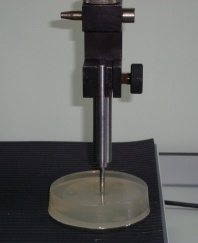Computational Biomechanics Group -Researches
|
| |
| A Multigrid Approach For Real-Time Simulation Of Deformable Tissues |
The efficient numerical simulation of deformable bodies is an ongoing research area with applications in a number of different fields. However, accuracy is often sacrificed for computational speed. Realistic modeling of soft tissues is difficult to obtain because of behavioral properties of soft tissues. For small deformations linear elasticity theories handles various scenarios for real time deformation simulations of soft tissues. For realistic solution of deformable objects specifically soft tissues, non-linear elasticity theories and their application in continuum mechanics are needed.
The main goal of the study is to demonstrate accurate simulation by taking geometric nonlinearity and material nonlinearity of the deformable model into account and to review the question whether the real time simulation is achievable with the integration of multigrid methods.
Therefore, in this study, we will represent an appropriate finite element hierarchy, which allows for an efficient implementation of multigrid components. The result is a method that uniformly damps all error frequencies with a computational cost that depends only linearly on the problem size.
|
|
Determining Material Coefficients of Soft Tissues Using Experimental
Data and Finite Elements Method |
The modeling of deformation behavior of soft tissues under known
boundary conditions and forces is fruitful research in engineering
and biomedical area that is found in various applications such as
virtual surgery, blood flow simulation, implant operations etc.
Accurate modeling of this tissue deformation bahaviour is
proportianal to the mathematical power of the proposed model and the
accurate determination of the material coefficients that are used in
the model to feature material properties.
Determining the coefficients of anisotropic, nonlinear,
inhomogeneous and viscoelastic materials is possible only via
experimental work on that material. Closer to reality is set the
conditions of the experimental environment during loading
experiments, more accurate observations of the material deformation
behavior can be made, thus, more accurate force-displacement data
can be obtained. Experiment data holds the information related to
the characteristics of the material, so the coefficients related to
these characteristics can be estimated using finite elements
modeling tools.
In this study, loading experiments, both on animal organs (bovine
liver) and artificial viscoelastic material presenting similar
behavior to liver, are made. Experiment data is used to obtain
material properties using Abaqus6.8 finite elements modeling
software.

|
| Non-Newtonian Blood Flow Simulation in Carotid Artery Bifurcation |
Hemodynamic is thought to play an important role for the localization of vascular disease in the arteries. Usually, local hemodynamic is not only governed by geometry of flow and the properties of the arterial wall, but also by the rheological properties of blood.
It is well known that blood behaves as a non-Newtonian fluid, particularly at low shear rate less than 100 s^-1. Some model take blood flow to be Newtonian, on assumption that the shear rates are greater than 100 s^-1. However, some studies indicates that non-Newtonian properties influence the blood flow importantly so this properties must be taken into account in the studies. Moreover, there is no constitutive equation of rheological properties of blood universally accepted. Various non-Newtonian constitutive models are employed in the studies.
In this studies, three non-newtonian blood models (Carreau, Casson, Generalised Power Law), as well as the usual Newtonian model of blood viscosity are used to study the wall shear stress and the velocity distribution in the cardiac cycle. Three dimensional, incompressible Navier-Stokes equation couped with non-Newtonian model is solved with Fluent Inc. The numerical results on the wall shear stress and the velocity distribution are discussed and compared with each other.
|
| Computational Blood Clotting Modelling |
The clotting mechanism is one of the most important and complex of physiologic systems. Blood must flow freely through the blood vessels in order to sustain life. But if a blood vessel is traumatized, the blood must clot to prevent life from flowing away. Thus, the blood must provide a system that can be activated instantaneously – and that can be contained locally – to stop the flow of blood. This system is called the clotting mechanism.
Blood clotting generally involves two interacting processes known as blood platelet aggregation and coagulation. The aggregation of blood platelets is normally initiated by the release of chemicals to blood plasma from damaged tissues in an injured blood vessel. When bleeding occurs, chemical reactions change the surface of the platelet to make it “sticky.” Sticky platelets are said to have become “activated.” These activated platelets begin adhering to the wall of the blood vessel at the site of bleeding, and within a few minutes they form what is called a “white clot.” The injured vessel also triggers a series of enzymatic reactions, leading to the process of blood coagulation. The activated clotting proteins engage in a cascade of chemical reactions that finally produce a substance called fibrin. Fibrin can be thought of as a long, sticky string. Fibrin strands stick to the exposed vessel wall, clumping together and forming a web-like complex of strands. Red blood cells become caught up in the web, and a “red clot” forms. A mature blood clot consists of both platelets and fibrin strands. The strands of fibrin bind the platelets together, and “tighten” the clot to make it stable.
In our research, we consider a coupled Lattice Boltzmann Method (LBM) and discrete element method (DEM) for the numerical modeling of the blood clot formation. We consider LBM for blood plasma flow simulation and DEM for thrombi formation due to platelet aggregation/coagulation modeling. For blood flow modeling we implement a non-Newtonian correction in order to reproduce more realistic flow profiles and for interaction between platelets and platelet/blood vessel wall we implement simplified piecewise linear distance-force function. Finally we described the clotting process with viewpoint of particle aggregation.
|
| |
|
<< Click here for previous page
|
|
